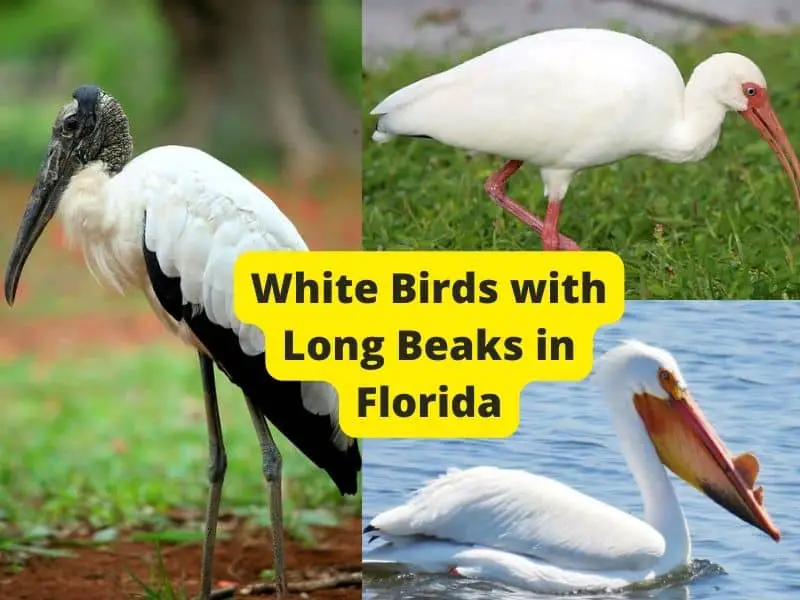Did you see a white bird in Florida? Does it have a long beak? Still struggling to ID it? Then this article is the resource you are looking for.
There are about 24 white birds in Florida. Out of them, 3 birds have clearly distinguishable long beaks. Those are,
- White Ibis
- Wood Stork
- American White Pelican
White Birds in Florida with Long Beaks
Unique long bills and white bodies of White Ibis, Wood Stork, and American White Pelican make it easy for us to identify them in the field. Check out the following bird photos and ID guides to confirm your guesses.
1. White Ibis

How to identify White Ibis (Quickly)
- Body: Adults are white with a little black on the wingtips. It has red facial skin.
- Bill: Long downward-curved orange-red bill (distinctive feature)
- Leg color: Pinkish-red
The White Ibis is a very distinctive bird, with its long, curved beak and white plumage. These birds are common in Florida and other parts of the southern United States, where they can be seen wading in shallow water or feeding in fields and marshes.
White Ibises are not shy birds and can often be seen close to humans. Females are similar to males in appearance but smaller in size. And also, their bills are less curved than males. However, immatures are half brown and half white.
2. Wood Stork

How to identify Wood Stork (Quickly)
- Body: Head and upper neck of the Wood Stork are featherless and blackish in color. It has a white body with black flight feathers.
- Bill: Long downward-curved dark bill
- Leg color: Blackish gray
Wood Stork is a large wading bird. And, it is the only stork that breeds in North America. It is very distinctive due to its unique appearance.
Wood Storks are unique in their appearance. Its body is white. In flight, the black tips of the flying feathers are clearly noticeable. And it has a short black tail. Its unique feature is its featherless upper neck and head that covers with scaly skin.
But, juvenile Wood Storks have thin grayish feathers on their head. And their bills are also pale yellow in color.
Wood Storks mostly forage in coastal areas, swamps, marshes, and forested freshwater. They breed in Florida to North Carolina.
In Florida, you can see Wood Storks year-round. But, the best time to see them is during the winter.
3. American White Pelican

How to identify American White Pelican (Quickly)
- Body: Large white body and white head with black outer wing feathers
- Bill: Huge long bill with an expandable throat pouch. Breeding adults have a ridge on the bill. Bill is orange-yellow in breeding birds and turns duller yellow in the nonbreeding season.
American White Pelican is an enormous white bird with an oversized, bright yellow-to-orange bill. Hence, you will easily identify them in the field. It has yellow legs, yellow feet, and black outer wind feathers.
During the breeding season, American White Pelican has a bright orange bill, legs, and feet. And in the post-breeding period, adults that are feeding young, have a gray-black crown. And, females look the same as males.
It forages usually in groups on lakes, and slow reservoirs. It swims together and beats its wings in coordinated movements to drive fish into shallow water. They dip their bills simultaneously into the water to catch fish. Most of its population has concentrated in just a small number of large colonies in isolated wetland complexes.
Information of White Birds with Long Beaks in Florida
| Feature/Data | White Ibis | Wood Stork | American White Pelican |
| Length | about 25 inches (64 cm) | about 39 inches (100 cm) | 54 – 66 inches (130 – 170 cm) |
| Wingspan | about 38 inches (96 cm) | about 5 ft (150 cm) | 93 – 112 inches (240 – 290 cm) |
| Bill | Long downward-curved orange-red bill | Long downward-curved dark bill | Huge long bill with an expandable throat pouch |
| Legs | Pinkish-red | Blackish gray | Short yellow legs |
| Conservation Status | Secure | Secure | Secure |
| Frequency (in Florida) | 34% – year-round | 17.2% – winter and 11.5% – year-round | 8.5% – winter and 3.8% – year-round |
| Food | Aquatic insects, crustaceans, fish, frogs | Fish, scrab, and insects (aquatic prey) | Mainly small fish, small amphibians |
Note that the frequency mentioned above is based on how much each bird is recorded in the complete checklists submitted to ebird.
As per the above data, we can see that all three birds are large in size. And they have been quite frequently spotted in Florida, especially during the winter. And also they are mostly foraging in wetlands and coastal area.
Hence, if you are need to see them in Florida, best places to look would be coatal area and wetlands and the best time would be during the winter.
Conclusion
Florida is home to many white birds. Hence, most probably you may have seen many of them if you did birding there. And, how many white birds you saw had long beaks?
This article lists and provides identification guides for three white birds in Florida that have long beaks. Those are,
- White Ibis
- Wood Stork
- American White Pelican
All three white birds are common in Florida and you can spot them frequently in wetlands.
And, you may also like:




